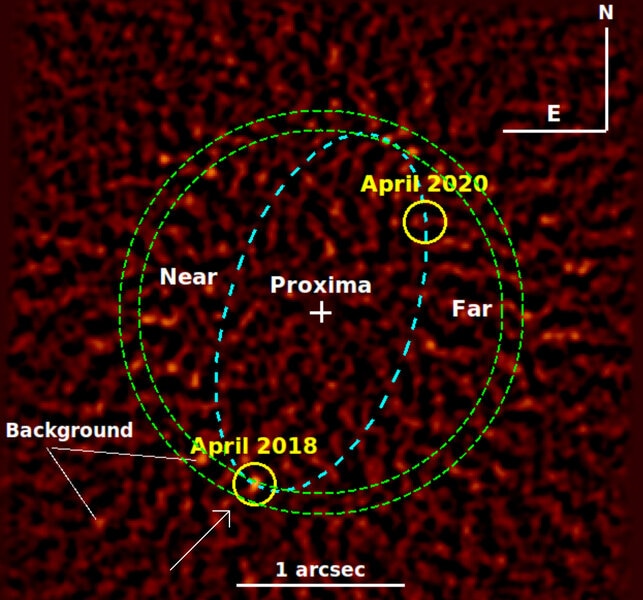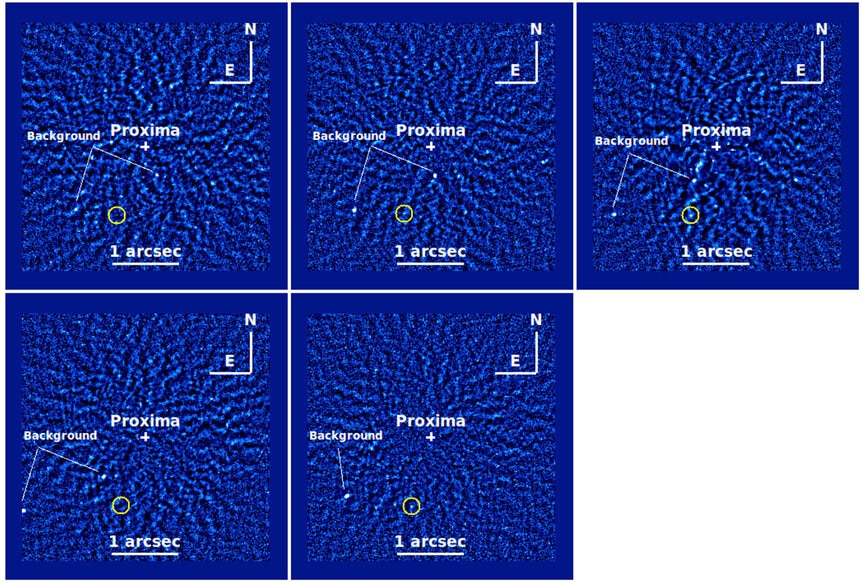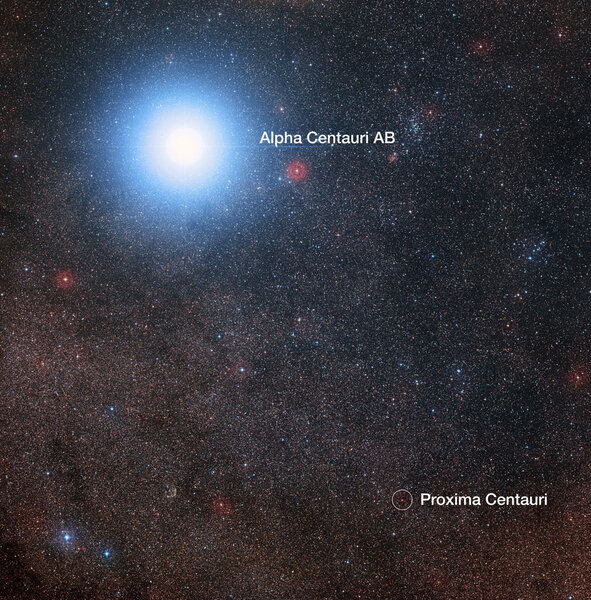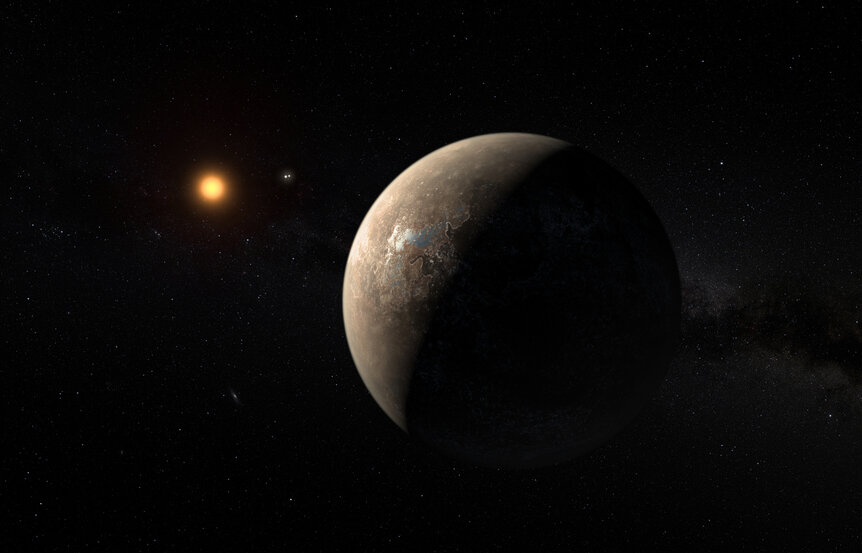Create a free profile to get unlimited access to exclusive videos, sweepstakes, and more!
Is this an actual image of a planet orbiting the nearest star? Maaaaaaaybe.
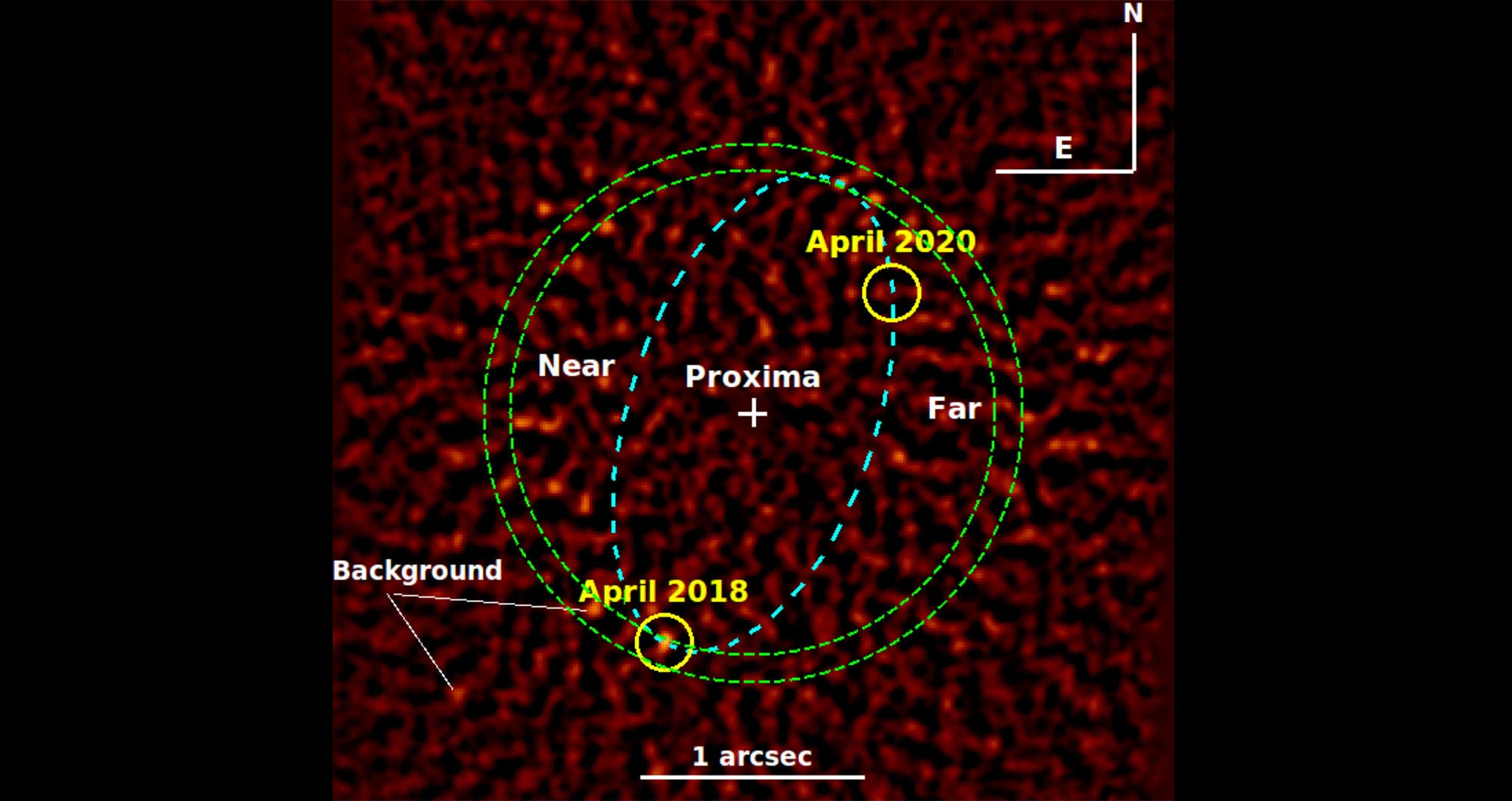
Well cripes, this didn't take long: Just a couple of weeks after astronomers announced that there's evidence of a possible second planet orbiting Proxima Centauri, the closest star to the Sun, another group has announced they may have an actual image of it!
Before we get started I want to be super clear: This is by no means confirmed, and the detection is a little shaky. A lot more work and a lot more observations will be needed to see if this pans out as an actual detection of the planet, as the authors make clear in their journal paper. I'll get into that in a moment.
But first, here's the image:
This is a combination of five separate images taken over a period of two months starting in April 2018. The yellow circle at the bottom shows the location of the candidate planet (the upper yellow circle shows its location now as a reference to its orbital motion over time). The dashed blue ellipse is the predicted orbit of the planet as seen on the sky. Given the predicted location of the planet, the search for candidates was confined to be between the two green dashed circles. The white plus marks the position of the star Proxima Centauri; its light has been removed using sophisticated mathematical techniques to reduce the glare that would otherwise overwhelm the image. Two background stars are noted as well. The scalebar is one arcsecond, an angle on the sky of 1/3600th of a degree (the full Moon on the sky is about 0.5° or 1800 arcseconds wide, so as you can see this is a pretty tiny angle).
So, is this a planet?
There does appear to be something there, but unfortunately they can’t definitively claim it’s real. See the weird ripples all over the image? Those are fluctuations in light on the detector, mostly caused by sky background and leftover light from Proxima that wasn’t totally removed. We call that noise. The planet candidate is about as bright as the brightest of those ripples, so it’s entirely possible it’s just noise, too.
The astronomers — understanding the weight of what they’re hoping to see here — go into quite a bit detail on what they did processing the images and reducing noise, and also trying to figure out if this blip is just a random fluctuation or an actual, y’know, planet.
The evidence the blip is real is enough for me to go, "Hmmmmmm…" but not enough for me to go "HOLY CRAP THEY FOUND A PLANET!" Somewhere in between the two, then, though for now much closer to the first one.
Interestingly, the position of the blip is consistent with observations of what may be rings of dust orbiting Proxima seen in earlier observations (though last I heard their existence is in doubt as well, which the authors of this new paper also mention, to their credit). However, a position for a planet was also calculated using data from the Gaia satellite, and the position found in these new images is not very consistent with that. That's a mark against it. However, the jury is not in on that just yet; new observational updates from Gaia will be released soon that should make it much more clear where the planet should be as seen by that observatory. Hopefully that'll clear some of this up.
As for the image itself, assuming it does show a planet, what can we figure out from it? Well, the light we see from it would be entirely due to reflected light from Proxima (very young planets glow with their own heat, but Proxima is nearly 5 billion years old, so that’s not an issue). Given its distance from the star, the brightness tells us how big it must be, and they find a planetary diameter of about 700,000 kilometers, or roughly 5 times the diameter of Jupiter.
Well, that's a problem! Planets don’t get that big, and in fact the mass of the planet is more like Neptune’s (roughly eight times Earth's mass) so that doesn't seem to fit at all. But the size is calculated from the brightness. What if something else were adding to the light?
Again, going with the assumption that the blip is in fact a planet, the authors propose that its brightness might be increased if it has a large ring system (possibly bigger even than Saturn’s) or dust clouds around it reflecting light, making it look brighter. That would mean the planet itself is much smaller. That actually makes sense; icy rings are highly reflective and can easily brighten a planet considerably.
The reason this is a big deal is because if true this would be the closest exoplanet ever directly imaged, and in fact the closest one we can image because it's orbiting the closest star in the Universe to us outside the Sun! That's incredible.
We know there’s at least one planet orbiting Proxima; it was found in 2016 and has been subsequently confirmed. Called Proxima Centauri b, it’s real, though far too close to the star to see in an image like this. Finding a second planet is a big deal in that sense too in that it helps us define the planetary system; if we assume the planets orbit in the same plane (just as our own solar system planets do) that helps constrain a lot of the physical characteristics of the planets.
Also, the candidate planet (Proxima Centauri c, if and when it's confirmed) was found using what’s called the radial velocity effect, basically it tugs on the star with its gravity as it orbits, which can (just barely) be detected from Earth. If confirmed, it'll be the first time a planet detected using the RV method has been directly seen due to reflected starlight. I know that’s a lot of adjectives, but that’s a big step in exoplanetary discoveries.
So what's next? Well, obviously, more observations. The best time to do this is when the planet (if it exists) is at the point in its orbit where it's farthest from the star. That reduces glare, but also it's when it appears to be moving most slowly due to perspective (we're seeing along the orbit at those points, so it's moving more or less toward or away from us, and not moving rapidly across our line of sight). The orbital period of the candidate planet is 1,900 days, so that should happen again in the next few months. Hopefully, more high-contrast images will be taken of this star to see what’s what.
So stay tuned. One way or another, if there's more news, I'll have it for you.
